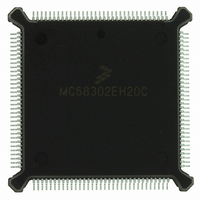MC68302EH20C Freescale Semiconductor, MC68302EH20C Datasheet - Page 41

MC68302EH20C
Manufacturer Part Number
MC68302EH20C
Description
IC MPU MULTI-PROTOCOL 132-PQFP
Manufacturer
Freescale Semiconductor
Datasheets
1.MC68302AG20C.pdf
(4 pages)
2.MC68302AG20C.pdf
(2 pages)
3.MC68302AG20C.pdf
(13 pages)
4.MC68302EH20C.pdf
(481 pages)
Specifications of MC68302EH20C
Processor Type
M683xx 32-Bit
Speed
20MHz
Voltage
5V
Mounting Type
Surface Mount
Package / Case
132-MQFP, 132-PQFP
Family Name
M68000
Device Core
ColdFire
Device Core Size
32b
Frequency (max)
20MHz
Instruction Set Architecture
RISC
Supply Voltage 1 (typ)
5V
Operating Temp Range
0C to 70C
Operating Temperature Classification
Commercial
Mounting
Surface Mount
Pin Count
132
Package Type
PQFP
Lead Free Status / RoHS Status
Lead free / RoHS Compliant
Features
-
Lead Free Status / Rohs Status
Compliant
Available stocks
Company
Part Number
Manufacturer
Quantity
Price
Company:
Part Number:
MC68302EH20C
Manufacturer:
Freescale Semiconductor
Quantity:
10 000
Part Number:
MC68302EH20C
Manufacturer:
FREESCALE
Quantity:
20 000
Company:
Part Number:
MC68302EH20CB1
Manufacturer:
Freescale Semiconductor
Quantity:
10 000
Company:
Part Number:
MC68302EH20CR2
Manufacturer:
Freescale Semiconductor
Quantity:
10 000
- MC68302AG20C PDF datasheet
- MC68302AG20C PDF datasheet #2
- MC68302AG20C PDF datasheet #3
- MC68302EH20C PDF datasheet #4
- Current page: 41 of 481
- Download datasheet (2Mb)
MC68000/MC68008 Core
2.5 INTERRUPT PROCESSING
Seven interrupt levels are provided by the M68000 core. If the IMP's interrupt controller is
placed in the normal mode, six levels are available to the user. If the interrupt controller is in
the dedicated mode, three levels are available to the user. In either mode, level 4 is reserved
for the on-chip peripherals. Devices may be chained externally within one of the available
priority levels, allowing an unlimited number of external peripheral devices to interrupt the
processor. The SR contains a 3-bit mask indicating the current processor priority level. In-
terrupts are inhibited for all priority levels less than or equal to the current processor priority
(see Figure 2-2).
An interrupt request is made to the processor by encoding the request on the interrupt re-
quest lines (normal mode) or by asserting the appropriate request line (dedicated mode).
Rather than forcing immediate exception processing, interrupt requests arriving at the pro-
cessor are made pending to be detected between instruction executions.
If the priority of the pending interrupt is lower than or equal to the current processor priority,
execution continues with the next instruction, and the interrupt exception processing is post-
poned.
If the priority of the pending interrupt is greater than the current processor priority, the ex-
ception processing sequence is started. A copy of the SR is saved, the privilege state is set
to supervisor state, tracing is suppressed, and the processor priority level is set to the level
of the interrupt being acknowledged. The processor fetches the vector number from the in-
terrupting device, classifying the reference as an interrupt acknowledge on the address bus.
If external logic requests automatic vectoring (via the AVEC pin), the processor internally
generates a vector number determined by the interrupt level number. If external logic indi-
cates a bus error, the interrupt is considered spurious, and the generated vector number ref-
erences the spurious interrupt vector number.
2.6 M68000 SIGNAL DIFFERENCES
The MC68302 core supports one additional signal not visible on the standard M68000:
RMC. Asserted externally on read-modify-write cycles, the RMC signal is typically used as
a bus lock to ensure integrity of instructions using the locked read-modify-write operation of
the test and set (TAS) instruction. The RMC signal from the M68000 core is applied to the
MC68302 arbiter and can be programmed to prevent the arbiter from issuing bus grants until
the completion of an MC68000-core-initiated read-modify-write cycle.
The MC68302 can be programmed to use the RMC signal to negate address strobe (AS) at
the end of the read portion of the cycle and assert AS at the beginning of the write portion
of the cycle (See 3.8.3 System Control Bits).
Two M6800 signals are omitted from the MC68302: valid memory address (VMA) and en-
able (E). The valid peripheral address (VPA) signal is retained, but is only used on the
MC68302 as AVEC to direct the core to use an autovector during interrupt acknowledge cy-
cles.
MOTOROLA
MC68302 USER’S MANUAL
2-11
Related parts for MC68302EH20C
Image
Part Number
Description
Manufacturer
Datasheet
Request
R
Part Number:
Description:
Manufacturer:
Freescale Semiconductor, Inc
Datasheet:

Part Number:
Description:
MC68302 Configuring the Chip Selects on the MC68302
Manufacturer:
Motorola / Freescale Semiconductor

Part Number:
Description:
MC68302 Design Concept - Expanding Interrupts on the MC68302
Manufacturer:
Motorola / Freescale Semiconductor

Part Number:
Description:
MC68302 MC68302 Adapting a WAN Controller to a LAN Environment
Manufacturer:
Motorola / Freescale Semiconductor

Part Number:
Description:
MC68302 EKB Applications - Power Measurements on the MC68302
Manufacturer:
Motorola / Freescale Semiconductor

Part Number:
Description:
MC68302 Interfacing the MC68020 to a Slave MC68302
Manufacturer:
Motorola / Freescale Semiconductor

Part Number:
Description:
MC68302 MC68302 Software Performance
Manufacturer:
Motorola / Freescale Semiconductor

Part Number:
Description:
MC68302 Evaluating EDX on the ADS302
Manufacturer:
Motorola / Freescale Semiconductor

Part Number:
Description:
MC68302 Design Advisory #1 - MC68SC302 Passive ISDN Protocol Engine
Manufacturer:
Motorola / Freescale Semiconductor

Part Number:
Description:
MC68302, MC68360, and MPC860 Characteristics and Design Notes for Crystal Feedback Oscillators
Manufacturer:
Motorola / Freescale Semiconductor
Part Number:
Description:
Mc68302 Integrated Multi-protocol Processor
Manufacturer:
Freescale Semiconductor, Inc
Datasheet:
Part Number:
Description:
Manufacturer:
Freescale Semiconductor, Inc
Datasheet:
Part Number:
Description:
Manufacturer:
Freescale Semiconductor, Inc
Datasheet:
Part Number:
Description:
Manufacturer:
Freescale Semiconductor, Inc
Datasheet:
Part Number:
Description:
Manufacturer:
Freescale Semiconductor, Inc
Datasheet:











